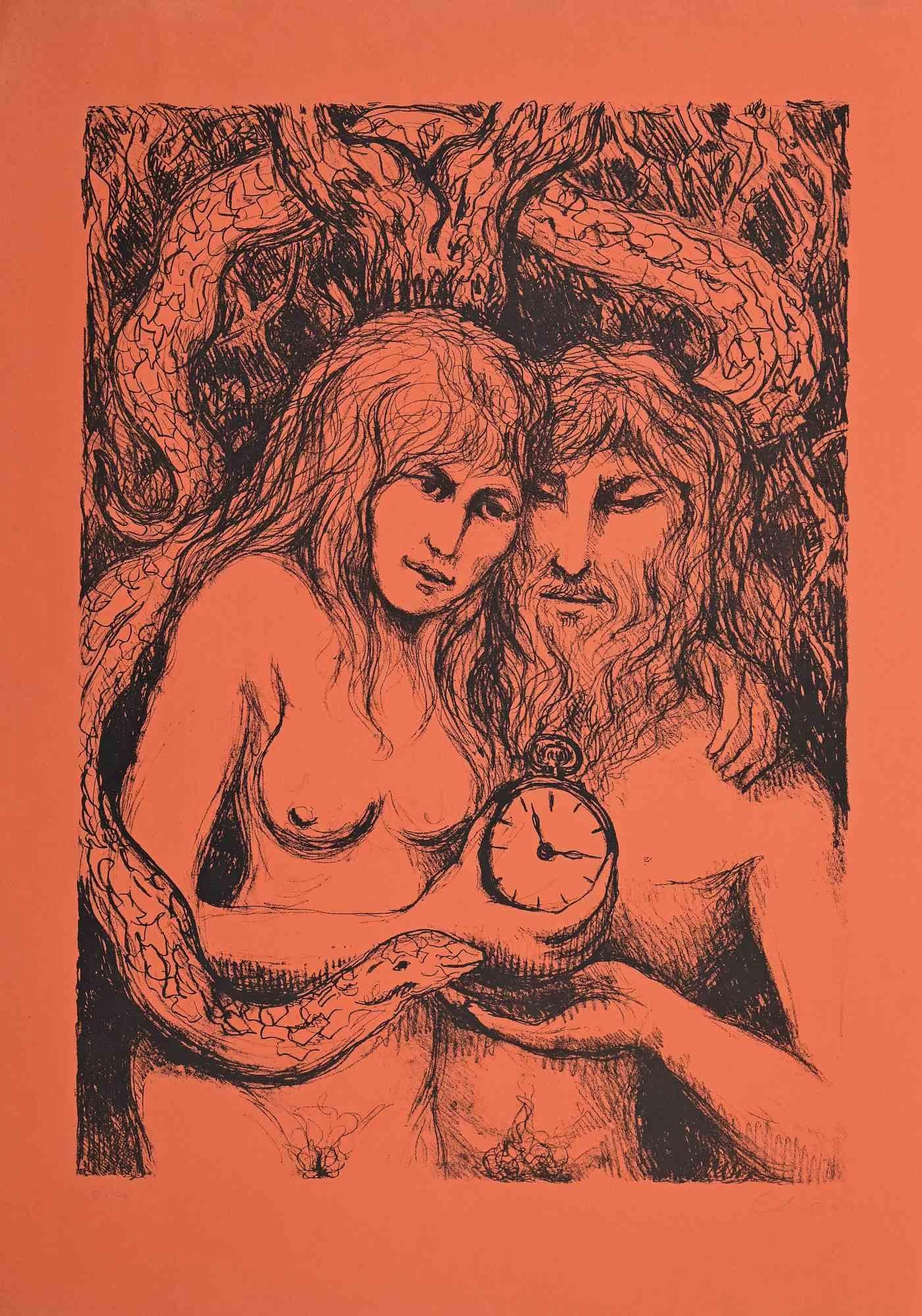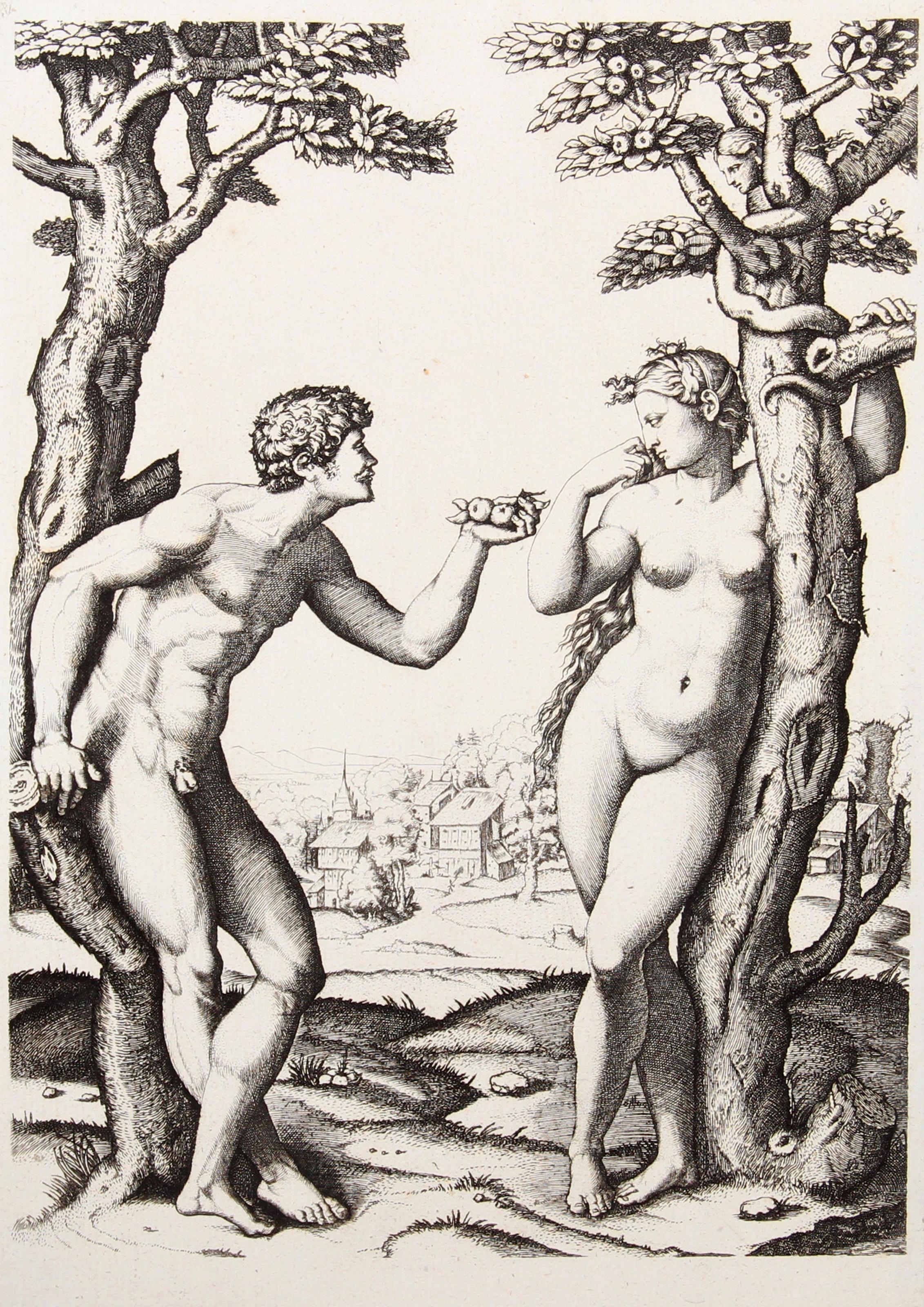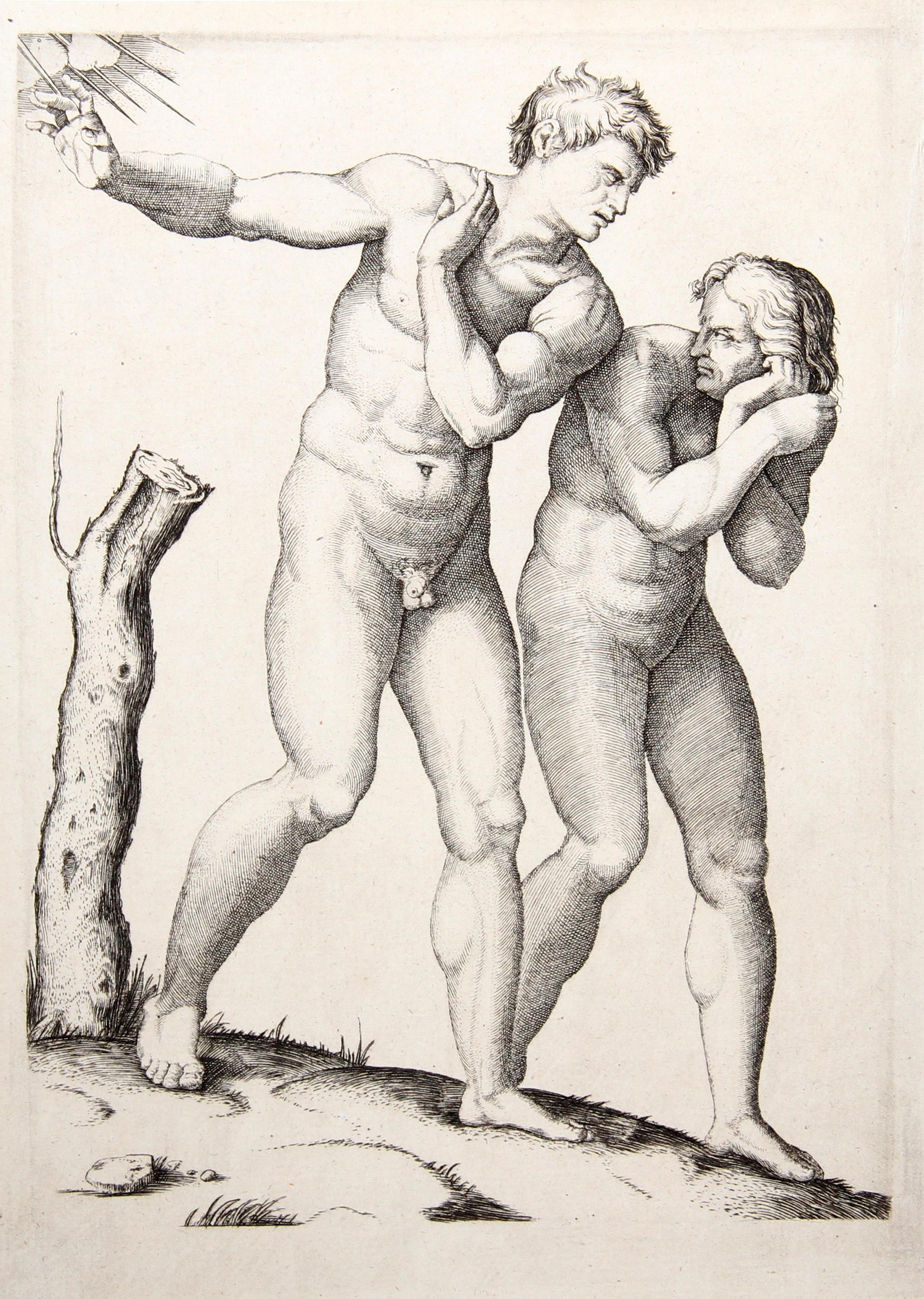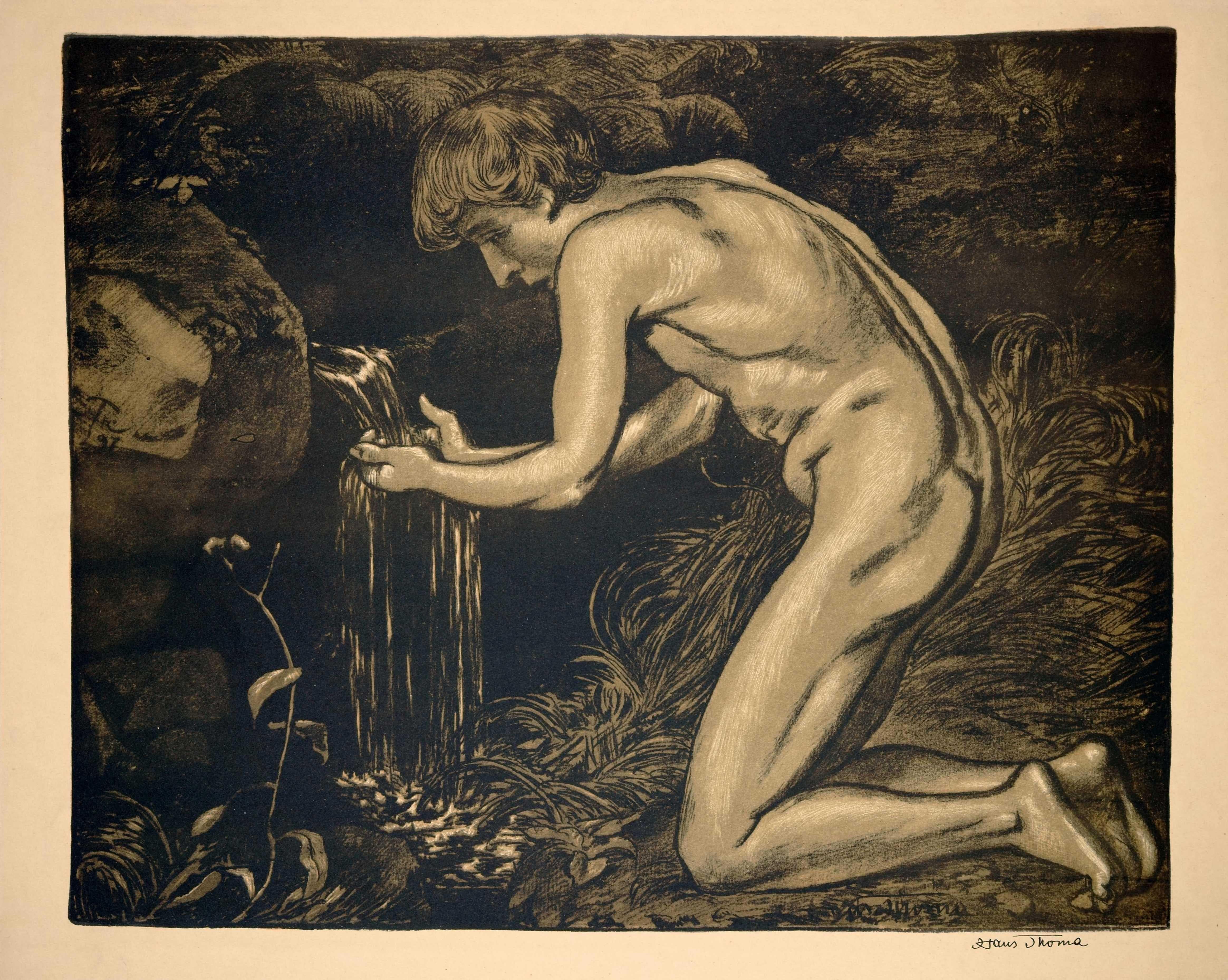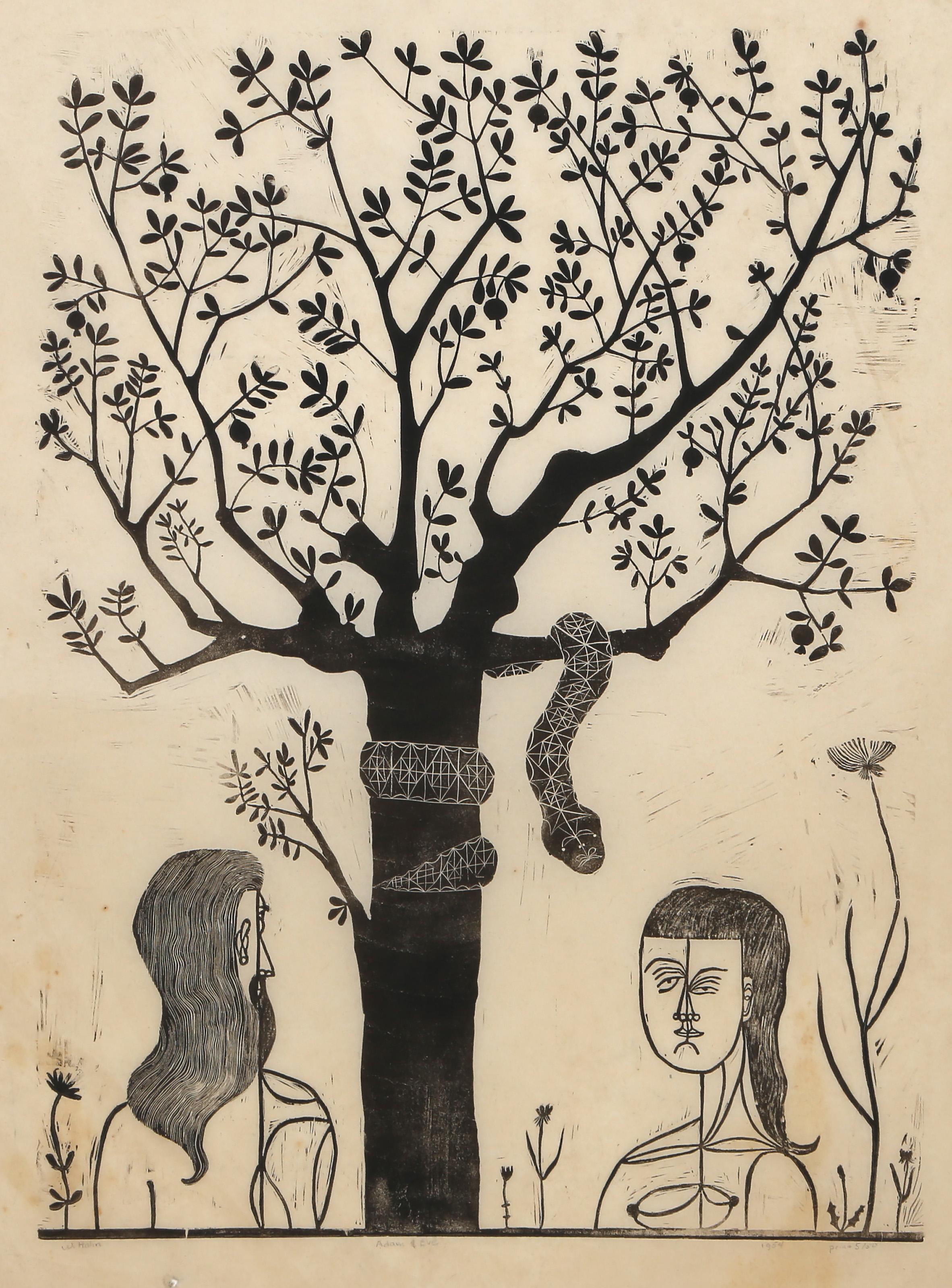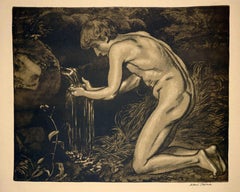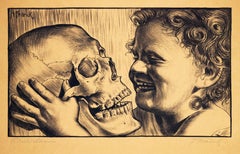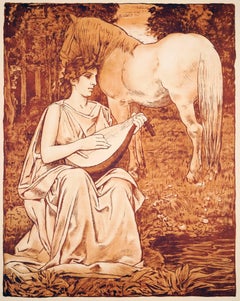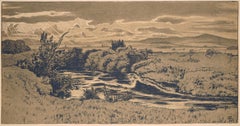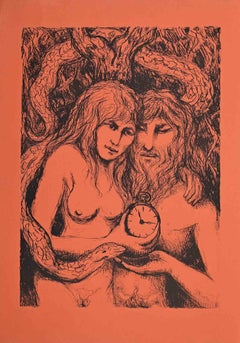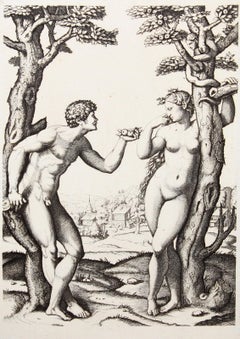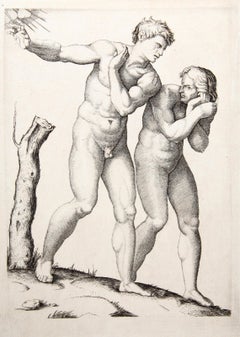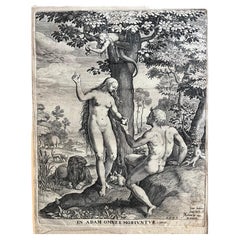Items Similar to Adam and Eve / - United in Death -
Want more images or videos?
Request additional images or videos from the seller
1 of 8
Hans ThomaAdam and Eve / - United in Death -1904
1904
$228.30
$285.3720% Off
£171.24
£214.0520% Off
€192
€24020% Off
CA$318.70
CA$398.3820% Off
A$345.19
A$431.4920% Off
CHF 182.83
CHF 228.5420% Off
MX$4,176.30
MX$5,220.3720% Off
NOK 2,298.44
NOK 2,873.0520% Off
SEK 2,142.63
SEK 2,678.2920% Off
DKK 1,462.62
DKK 1,828.2820% Off
About the Item
Hans Thoma (1839 Bernau - 1924 Karlsruhe), Adam and Eve, 1897. Algraph on strong wove paper, published by Breitkopf und Härtel in Leipzig as ‘Zeitgenössisches Kunstblatt Nr. 113’, 44.5 cm x 29.5 cm (image), 50 cm x 40 cm (sheet size), signed and dated lower right. Verso with publisher's sticker.
- Two marginal tears in the right wide margin, crease in the upper left area
- United in Death -
With his depiction of the Fall of Man, Hans Thoma addresses one of the most significant themes in Western art history. This subject was often portrayed, especially during the Renaissance, due to the depiction of naked bodies. If the Fall of Man is a turning away from God, Thoma emphasizes what separates and connects Adam and Eve. The tree and its branches physically separate them, as reflected in their body language. While Eve reaches for the apple and looks at the serpent as a temptress would, Adam stands introverted, seeming to look inward with a melancholy gaze at the consequences of the Fall of Man. However, Eve also appears sad and serious. Beyond their shared mood, the symmetrical positioning of their feet and the bush growing toward both of them connect the first human couple. Most importantly, however, it is the death behind them that unites Adam and Eve with the stretched cloth. They are united in their mortality.
About the artist
After failing to complete his apprenticeship as a lithographer, painter and clockmaker, Hans Thoma trained as an autodidact painter. In 1859 he won a scholarship to the Karlsruhe Art School, where he became a student of Wilhelm Schirmer and Ludwig Des Coudres. After graduating in 1866, Thoma spent time in Basel and Düsseldorf. He met Otto Scholderer, with whom he traveled to Paris in 1868. There he was impressed by the art of Gustave Courbet and the Barbizon School. After his works were rejected by the Karlsruhe Kunstverein, Thoma moved to Munich in 1870, where he was close to the Leibl circle. Wilhelm Trüber worked for a time in Thoma's studio in Munich. In 1874 he made the first of a series of trips to Italy with the painter Albert Lang, where he met Hans von Marées and Adolph von Hildebrand and became friends with Arnold Böcklin, whose art made a lasting impression on Thoma. On his return to Munich, Thoma became a student of Cella Berteneder, whom he married in 1877.
Thoma traveled to England in 1879 at the invitation of art collector Charles Minoprio. Over the years, Minoprio acquired more than 60 oil paintings by Thoma and organized the first exhibition of his art abroad in Liverpool in 1884. Thoma had lived in Frankfurt since 1878. The following year, the Frankfurter Kunstverein organized the first solo exhibition of his work. After a trip to the Netherlands, Thoma moved to Kronberg im Taunus in 1899, where the Kronberg painters' colony was based. That same year he was appointed professor at the Karlsruhe Art School and director of the Karlsruhe Kunsthalle. In 1901, together with Wilhelm Süs, Hans Thoma founded the Grand Ducal Majolica Manufactory in Karlsruhe, for which he supplied designs from then on.
Thoma was now at the height of his artistic fame. The 1909 edition of Meyer's Großes Konversations-Lexikon noted that Thoma had become one of the German people's favorite painters. On the occasion of his 80th birthday in 1919, Ernst Oppler and Lovis Corinth organized a large celebration. After Thoma's death, the Berlin National Gallery dedicated a major exhibition to him in 1922, and the Basel Kunsthalle in 1924.
GERMAN VERSION
Hans Thoma (1839 Bernau - 1924 Karlsruhe), Adam und Eva, 1897. Algraphie auf kräftigem Velin, bei Breitkopf und Härtel in Leipzig als ‚Zeitgenössisches Kunstblatt Nr. 113‘ erschienen, 44,5 cm x 29,5 cm (Darstellung), 50 cm x 40 cm (Blattgröße), rechts unten mit Signet und Datierung versehen. Rückseitig mit Verlagsaufkleber.
- zwei Randeinrisse im rechten breiten Rand, Knickspur im oberen linken Bereich
- Im Tode vereinigt -
Mit der Veranschaulichung des Sündenfalls greift Hans Thoma eines der zentralen Bildthemen der abendländischen Kunstgeschichte auf, das aufgrund der nackten Körper insbesondere in der Renaissance vielfach darstellt wurde. Ist der Sündenfall eine Abwendung des Menschen von Gott, so stellt Thoma hier das Adam und Eva Trennende und sie miteinander Verbindende heraus. Der Baum und mit ihm die Schlage separieren Adam und Eva voneinander, was sich auch in der unterschiedlichen Körpersprache zeigt. Greift Eva nach dem Apfel und schaut dabei die züngelnde Schlange als Verführerin an, steht Adam in sich gekehrt dort und scheint mit melancholisch nach innen gerichtetem Blick die Tragweite des Sündenfalls zu schauen. Aber auch Eva ist von einem traurigen Ernst erfüllt. Über die gemeinsame Gestimmtheit hinaus, verbindet die symmetrische Fußstellung und der gleichermaßen zu Eva wie zu Adam wachsenden Busch das erste Menschenpaar miteinander. Vor allem ist es aber der hinter ihnen stehende Tod, der mit dem ausgespannten Tuch Adam und Eva zusammenschließt. Sie sind in ihrer Sterblichkeit vereint.
zum Künstler
Nachdem er Lehren als Lithograph, Anstreicher und Uhrschildmaler abgebrochen hatte, bildete sich Hans Thoma autodidaktisch als Kunstmaler. Dies brachte ihm 1859 ein Stipendium für die Kunstschule in Karlsruhe ein, wo er Schüler von Wilhelm Schirmer und Ludwig Des Coudres wurde. Nach Abschluss des Studiums, 1866, hielt sich Thoma in Basel und Düsseldorf auf. Er lernte Otto Scholderer kennen, mit dem er 1868 nach Paris reiste. Dort beeindruckten ihn die Kunst Gustave Courbets und die Schule von Barbizon. Nach der Ablehnung seiner Werke im Karlsruher Kunstverein wurde Thoma 1870 in München ansässig, wo er dem Leibl-Kreis nahestand. In München arbeitete Wilhelm Trüber zeitweise in Thomas Atelier. 1874 erfolgte zusammen mit dem Maler Albert Lang die erster einer Reihe von Italienreisen, auf der er Hans von Marées und Adolph von Hildebrand kennenlernte und mit Arnold Böcklin Freundschaft schloss, dessen Kunst Thoma nachhaltig beeindruckte. Nach seiner Rückkehr nach München wurde Cella Berteneder Thomas Schülerin, die er 1877 ehelichte.
Auf Einladung des Kunstsammlers Charles Minoprio reiste Thoma 1879 nach England. Im Laufe der Jahre erwarb Minoprio mehr als 60 Ölbilder Thomas und veranstaltete 1884 die erste Auslandsausstellung seiner Kunst in Liverpool. Ab 1878 lebte Thoma in Frankfurt. Im Folgejahr zeigte der Frankfurter Kunstverein die erste Einzelausstellung seiner Werke. Nach einer Reise in die Niederlande zog Thoma 1899 nach Kronberg im Taunus, wo die Kronberger Malerkolonie ansässig war. Im selben Jahr wurde er zum Professor der Karlsruher Kunstschule und zum Direkter der Karlsruher Kunsthalle berufen. 1901 war Hans Thoma mit Wilhelm Süs Gründer der Großherzoglichen Majolika-Manufaktur Karlsruhe, für die er fortan Entwürfe lieferte.
Thoma stand nun auf dem Höhepunkt seines künstlerischen Ruhmes. Meyers Großes Konversations-Lexikon stellt in der 1909 erschienen Auflage fest, Thoma sei zu einem Lieblingsmaler des deutschen Volkes geworden. Anlässlich des 80. Geburtstags, 1919, organisierten Ernst Oppler und Lovis Corinth eine große Feierlichkeit. Nachdem Thoma verstorben war, widmete ihm die Berliner Nationalgalerie 1922 und die Basler Kunsthalle 1924 eine große Werkschau.

About the Seller
5.0
Vetted Professional Seller
Every seller passes strict standards for authenticity and reliability
Established in 2014
1stDibs seller since 2023
22 sales on 1stDibs
- ShippingRetrieving quote...Shipping from: Berlin, Germany
- Return Policy
More From This Seller
View AllBoy at the source / - Elixir of Life -
Located in Berlin, DE
Hans Thoma (1839 Bernau - 1924 Karlsruhe), Boy at the source, 1897. Algraph on strong wove paper after a drawing from 1897, published by Breitkopf und Härtel in Leipzig as ‘Zeitgenös...
Category
1890s Realist Figurative Prints
Materials
Paper
$266 Sale Price
20% Off
Death and Life / - United in Laughter -
By Hans Frank
Located in Berlin, DE
Hans Frank (1884 Vienna - 1948 Salzburg), Death and Life, 1911. Lithograph, 18 cm x 31 cm (depiction), 25.5 cm x 38.7 cm (sheet size), signed “H.[ans] Frank” in pencil lower right and inscribed “Tod und Leben” lower left.
- darkened, remains of an old mounting on the verso
- United in Laughter -
Here, Hans Frank refers to the skull as a vanitas motif. In Renaissance and Baroque portraits, this motif symbolizes the transience of the sitter, whose head has become a skull over time. Penitents, such as St. Jerome, often hold skulls in melancholy contemplation. Here, however, the boy stands up for life itself. He boldly grabs the skull and laughs at the absurdity of life and death. The laughter of death joins the laughter of life, and vice versa. The child's thumb penetrates the skull's cheekbone to illustrate the inseparable connection between death and life.
About the artist
Hans Frank studied at the Vienna School of Applied Arts from 1902 to 1906 and then studied painting under Franz Rumpler at the Vienna Academy of Fine Arts from 1907 to 1911. In 1911, he received a substantial travel grant from the emperor, which he used to travel to Switzerland, Paris, London, Belgium, the Netherlands, and Germany. After serving in World War I, Frank moved to St. Marein im Mürztal, returning to Vienna in 1925. He took further study trips to Italy, southern France, and the Austrian countryside. In 1927, Frank became a member of the London Society of Color Printers. An exhibition of his work at the Medici Gallery in London brought him international recognition. He joined the Pasadena Printmakers Society of California and established contacts in Canada. In addition to his highly regarded paintings, Frank primarily worked as a graphic artist. He created over 300 prints and developed a new gradient technique for the fern woodcut with his twin brother, Leo Frank...
Category
1910s Jugendstil Figurative Prints
Materials
Paper
$361 Sale Price
20% Off
Muse / - In the realm of the muses -
Located in Berlin, DE
Hans Thoma (1839 Bernau - 1924 Karlsruhe), Muse, 1893. Algraph on strong wove paper, published by Breitkopf und Härtel in Leipzig as ‘Zeitgenössisches Kunstblatt Nr. 174’, 43.5 cm x ...
Category
1890s Realist Figurative Prints
Materials
Paper
$228 Sale Price
20% Off
At the pond / - The longing of the landscape -
Located in Berlin, DE
Hans Thoma (1839 Bernau - 1924 Karlsruhe), At the pond, 1897. Algraph on strong wove paper, published by Breitkopf und Härtel in Leipzig as ‘Zeitgenössisches Kunstblatt Nr. 148’, 23....
Category
1890s Realist Figurative Prints
Materials
Paper
$180 Sale Price
20% Off
Southern German summer landscape / - The profile of the landscape -
Located in Berlin, DE
Hans Thoma (1839 Bernau - 1924 Karlsruhe), Southern German summer landscape, around 1897. Algraph on strong wove paper, published by Breitkopf und Härtel in Leipzig as ‘Zeitgenössisc...
Category
1890s Realist Figurative Prints
Materials
Paper
$180 Sale Price
20% Off
S. Anton Patenkirchen / - The Home of the Landscape -
Located in Berlin, DE
Hans Thoma (1839 Bernau - 1924 Karlsruhe), S. Anton Patenkirchen, 1895. Algraph on strong wove paper, published by Breitkopf und Härtel in Leipzig as ‘Zeitgenössisches Kunstblatt Nr....
Category
1890s Realist Figurative Prints
Materials
Paper
$180 Sale Price
20% Off
You May Also Like
Adam and Eve - Lithograph by Carlo Levi - Mid 20th Century
By Carlo Levi
Located in Roma, IT
Adam and Eve is an original lithograph realized by Carlo Levi in mid-20th Century.
Good condition on a red cardboard.
Hand signed by the artist.
Carlo Levi (29 November 1902 – 4 ...
Category
Mid-20th Century Contemporary Figurative Prints
Materials
Lithograph
Adam et Eve, Heliogravure by Marcantonio Raimondi
By Marcantonio Raimondi
Located in Long Island City, NY
Marcantonio Raimondi, After by Amand Durand, Italian (1480 - 1534) - Adam et Eve, Year: 1875, Medium: Heliogravure on laid paper, Size: 10 x 7 in. (25.4 x 17.78 cm), Printer: Aman...
Category
1870s Old Masters Prints and Multiples
Materials
Etching
Adam et Eve Chasses du Paradis, Heliogravure by Marcantonio Raimondi
By Marcantonio Raimondi
Located in Long Island City, NY
Marcantonio Raimondi, After by Amand Durand, Italian (1480 - 1534) - Adam et Eve Chasses du Paradis, Year: 1875, Medium: Heliogravure, Size: 8.25 x 6 in. (20.96 x 15.24 cm), Print...
Category
1870s Old Masters Prints and Multiples
Materials
Etching
Adam and Eve Engraving by Johann Sadeler circa 1579
Located in Doylestown, PA
A rare engraving titled “IN ADAM OMNES MORIUNTUR” (All die in Adam) by Johann Sadeler after a work by Maerten de Vos, depicting Adam taking the forbidden fruit from Eve. Signed and...
Category
Antique 16th Century Dutch Renaissance Prints
Materials
Paper
Adam & Eve, Folk Art Woodblock by W Hahn
Located in Long Island City, NY
W Hahn - Adam & Eve, Year: 1954, Medium: Woodblock on Japon, signed, titled, numbered and dated in pencil, Edition: 5/50, Image Size: 15 x 11 inches, Size: 18.5 x 15 in. (46.99 ...
Category
1950s Folk Art Figurative Prints
Materials
Woodcut
Adam et Eve, Old Masters Heliogravure Etching by Lucas van Leyden
By Lucas van Leyden
Located in Long Island City, NY
Artist: Lucas van Leyden, After by Amand Durand, Dutch (1494 - 1533) - Adam et Eve, Year: 1873, Medium: Heliogravure, Size: 8 x 10 in. (20.32 x 25.4 cm), Printer: Amand Durand, Des...
Category
Late 19th Century Old Masters More Prints
Materials
Etching
